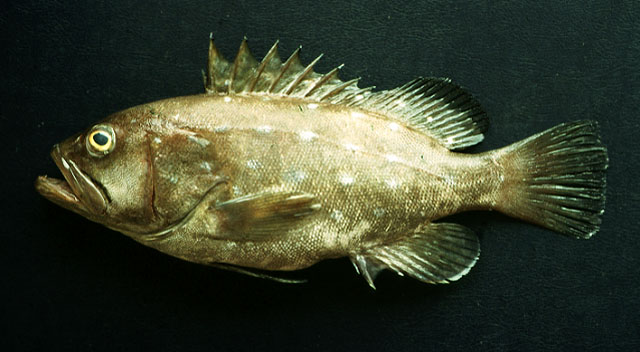| Epinephelidae (Groupers) |
| 48 cm SL (male/unsexed) |
|
demersal; marine; depth range 50 - 130 m |
| Eastern Pacific: southern California to Peru. Misidentified as Epinephelus niveatus by some authors (Ref. 5995, 6852). |
|
Dorsal spines (total): 11-11; Dorsal soft rays (total): 13-15; Anal spines: 3-3; Anal soft rays: 9-9. Distinguished by the following characteristics: juveniles dark reddish brown with white spots in grid-like pattern of vertical series and horizontal rows on body and dorsal fin; caudal peduncle with visible dark saddle blotch; pale caudal and pectoral fins; dark brown anal and pelvic fins; black maxillary groove; adults dark brown lacking white spots; depth of body contained 2.3-2.7 times in SL; head length 2.2-2.5 times in SL; convex interorbital area; slightly produced angle of preopercle, with enlarged serrae; distinctly convex upper edge of operculum; vertically elongate posterior nostrils, 2-5 times larger than anterior nostrils; maxilla reaches to or beyond vertical at rear edge of eye; 2 rows of teeth on midlateral part of lower jaw (Ref. 89707). |
| Found on rocky reefs and soft bottoms (Ref. 89707). Reported to be often caught in shrimp trawls in central Gulf of California. Too rare to be of commercial interest. |
|
Least Concern (LC); Date assessed: 20 November 2016 Ref. (130435)
|
| harmless |
Source and more info: www.fishbase.org. For personal, classroom, and other internal use only. Not for publication.

